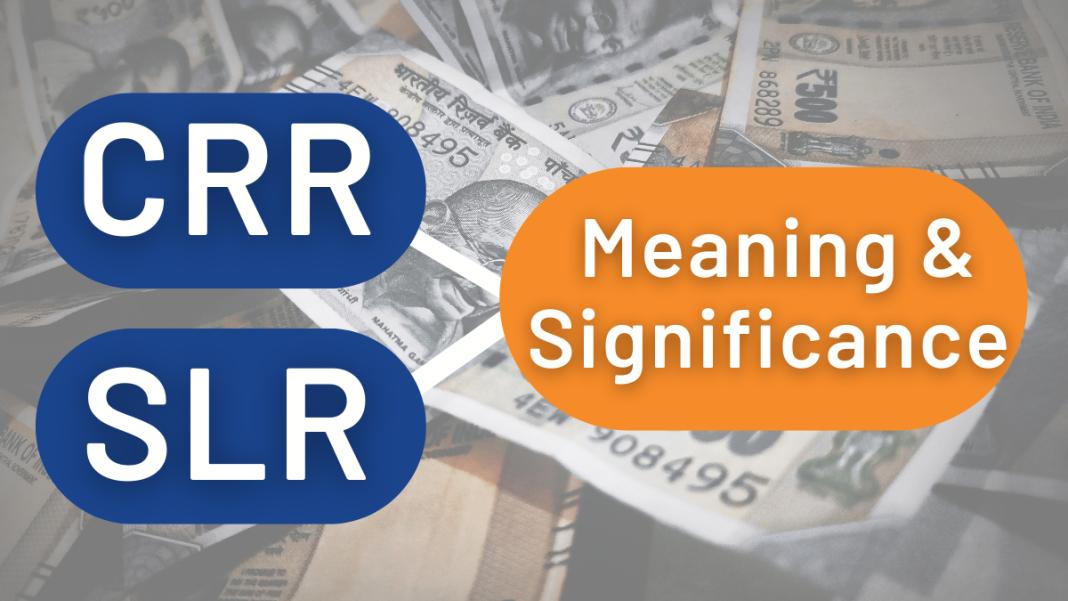We all know that the Reserve Bank of India performs the function of the implementation of the Monetary Policy of our country. The Preamble of RBI, thus underlines its aims of maintaining ‘price stability’ while maintaining the objective of ‘growth’. To fulfill these functions, RBI relies upon some of the monetary instruments, the Cash Reserve Ratio (CRR) & Statutory Liquidity Ratio (SLR) are one of such instruments.

What is CRR & SLR?
Maintaining cash flow of the economy is the primary aim of both of these monetary policy instruments.
CRR Meaning
The Cash Reserve Ratio is a certain percentage of a bank’s NDTL (Net Demand & Time Liabilities) that banks are required to keep in form of cash, with the RBI. Here, banks do not earn any interest on the money parked with the RBI. Currently CRR is 4.50 %.
SLR Meaning
The Statutory Liquidity Ratio is a certain percentage of a bank’s NDTL (Net Demand & Time Liabilities) that banks are required to maintain with themselves in the form of Government Securities, Gold or cash. Here, banks can earn interest as they are supposed to invest in government securities & bonds.
Both the definitions contain the term NDTL. What does it mean & what is the significance of it? Let’s see.
Net Demand & Time Liabilities
In simple words, NDTL is the deposits of the public at large, which is held in the banks.
As the Deposits of public are the liabilities of the banks, the Demand liabilities denote the deposits in the Current Account or Saving Account, which can be withdrawn at any time.
On the other hand, the Time liabilities are Fixed Deposits or Recurring Deposits which can only be withdrawn after a certain period of time.
The ‘Net’ part subtracts a bank’s own deposits in another bank from the DTL. So, let’s say that DTL of a bank is Rs 100 Crore and it has deposited Rs 10 Crore in another bank (which are its Asset & not Liability), then the NDTL is Rs 90 Crore. CRR & SLR is based on this Rs 90 Crore.
Impact of CRR & SLR
RBI changes the CRR & SLR according to the changing needs of economy & credit flow in the economy.
INCREASING CRR & SLR
Increase in CRR & SLR indicates that the RBI wants banks to keep more money in the reserve. This means that there would be a lesser amount available for banks to give loans. As the loanable amount is less, banks would raise the interest rates for the loans. This would discourage people to take more loans which would, in turn, reduce the liquidity in the economy, i.e. shortage of money. Reduced liquidity will also reduce the demand and in turn inflation in the economy.
REDUCING CRR & SLR
More money is available with the bank to lend. As, they now have to keep less amount in the reserves, with reduction in CRR & SLR. Now, because of more availability of money to lend, banks reduce the interest rates on loans. This further urges people to take more loans at a lesser expense. More loans given means increase in money supply i.e. increase in liquidity. That is why, there could be more demand in the market, giving rise to inflationary tendencies.
Hence, it is important to maintain balance between both growth & inflation. As, lesser CRR & SLR requirements would mean more money in the market & more growth prospects, but at the same time it may induce inflationary tendencies.
But, why can’t banks do their business with all the money that they have? Why is it important to have CRR & SLR instruments?
Why do we need CRR & SLR?
If we allow banks to run their business without the provisions of CRR & SLR, it would hamper the solvency of the banks. They would not have money to protect their depositors in case the loans given turn out to be non-performing assets (NPAs) or there is a high demand for cash withdrawals. Thus, the ultimate aim is to make sure that there’s always a certain amount of money kept against the deposits. Apart from this, CRR & SLR is important because:
· Maintains the liquidity in the banking system.
· It ensures the cash flow in the economy.
· Used to moderate the financial system in case of surplus rupee in the economy.
· Unlike other instruments which take time to generate results- like selling bonds, CRR & SLR are more reliable.
· Important tool to maintain inflation & growth prospects. (Learn more about Inflation Here)
Conclusion
This is how, RBI regularly monitors key indicators in the economy and revises the levels of CRR & SLR from time to time. If you understand these two basic concepts, you can tackle questions related to Inflation, Solvency, Repo Rates etc. Apart from their utility for exams, the CRR & SLR can help you make better investment decisions for yourself & also to help you understand different economic variables. You can refer to the RBI’s website to keep yourself updated with the latest CRR & SLR Rates.
To learn more such Concepts, visit the following link:
https://www.ixambee.com/cpss-concept
To help you prepare 50% faster for competitive exams, ixamBee provides free Mock Test Series all the Current Affairs in English and Current Affairs in Hindi in the BeePedia capsules for GA Preparation. You can also get the latest updates for Bank PO, Bank Clerk, SSC, RBI NABARD and Other Government Jobs.
Also Read:
iEX- ixamBee Exam Experience (Your Complete Exam Experience)
Importance of CONCEPTUAL CLARITY to clear ANY Government Exam














